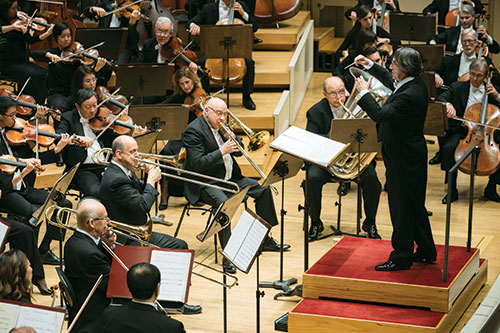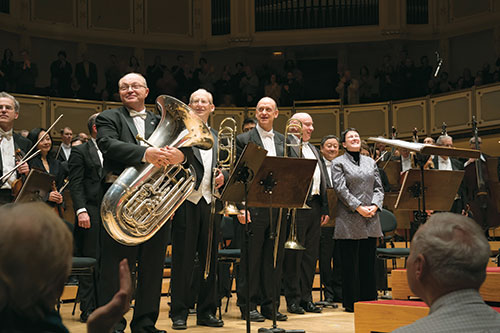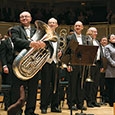
Photos courtesy of Todd Rosenberg Photography
I had the distinct pleasure to hear the Chicago Symphony Orchestra premiere the new Low Brass Concerto written by Pulitzer Prize-winning composer Jennifer Higdon. I have admired the sound, precision, and artistry of the CSO and in particular their brass section for over 30 years. When I learned that the low brass section would be performing a new work commissioned especially for them, I made it a point to attend. The composition was commissioned by the Chicago Symphony Orchestra and co-commissioned by the Philadelphia Orchestra and Boston Symphony. The media build-up prior to the performance weekend was remarkable in and of itself. Chicago television stations broadcast feature stories about the performance, and local print media carried stories. Social media proclaimed the merits of the CSO low brass section, hailed by many brass aficionados as one of the finest in the world. As a fellow low brass player (tuba), I was pleased to see so much attention lavished on the three trombonists and the tuba player of the Chicago Symphony Orchestra. Then again, Jay Friedman and Michael Mulcahy (trombone), Charles Vernon (bass trombone) and Gene Pokorny (tuba) are some of the best players in the world.
The performance itself was truly spectacular. The work begins with the four soloists playing a beautiful chorale by themselves. The refinement of the tone quality, the precision with which they changed notes, and the quality of their legato playing was truly wonderful. The Concerto lasts approximately 17 minutes, with no break between the slow and fast movements. At the request of the players, there are no cadenzas or special effects, such as mutes or glissandi. In fact, the players from both the Chicago Symphony Orchestra and the Philadelphia Orchestra both asked Higdon to write music that demonstrated the lyrical, melodic capabilities of the low brass section of the orchestra. Higdon did exactly that, while also scoring solo moments for each instrument, as well as duets and trios within the low brass section accompanied by the orchestra. In the program notes for the concert, Higdon is quoted, saying, “I thought about the beauty of the instruments and I also thought about the power of the instruments. I tried to build on just those two concepts.”
To my ears, she has succeeded. The artistry of the players was demonstrated many times as they played soft, lyrical phrases. Tuba player Gene Pokorny noted that Higdon made use of the contrabass tuba, that is, the full-sized tuba normally used in the orchestra, rather than the smaller, higher-pitched bass tuba often used by soloists. In fact, on this night, Pokorny played the famous York tuba used by his predecessor in the CSO, Arnold Jacobs. The virtuosity of these four musicians was demonstrated many times as well. Principal trombonist Jay Friedman performed a triple tongue passage so effortlessly and so smoothly that I literally had to replay the phrase in my head and count the notes, to make sure my initial impression was correct. All four players demonstrated an incredibly well-defined level of intonation, so pure and so beautiful that the harmonic series of the chords they played literally rang through the hall. Likewise, they demonstrated a unity of tone quality that often made the four sound like a single player. Higdon referred to this unity in her program notes: “This work . . . is a musical portrait of four extraordinary players, each working individually and as a group, bringing to the front of the stage all of their majesty, grace and power.”
– Thomas Bough
Northern Illinois University

Comments from Jennifer Higdon
How did this commission come about?
I was in Santa Fe, New Mexico, for the premiere of my opera, Cold Mountain, and we received an email from one of the administrators. She wrote that Maestro Muti would like for me to compose a low brass concerto for the Chicago Symphony and asked if I would be interested. My first reaction was fear of writing something that has not been done, but my second reaction was excitement at getting to write for the famous low brass section of the Chicago Symphony Orchestra.
How did your experiences teaching yourself how to play the flute and your experiences in high school band shape your career as a composer?
I think that both of these taught me the value of working at something every day to make it better. I try to compose every day I am at home, even when I don’t feel like it, because it is important to be diligent. As Picasso said, “inspiration exists, but it has to find us working.”
What should people know about writing for trombone and tuba? How easy/difficult is it to blend these instruments?
I hope that people will discover through this piece that trombone and tuba can be quiet, delicate, and beautiful. The power is certainly there but the beautiful side also exists and is sometimes overlooked.





